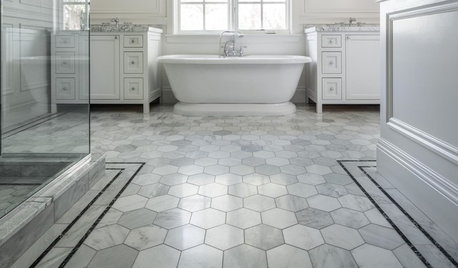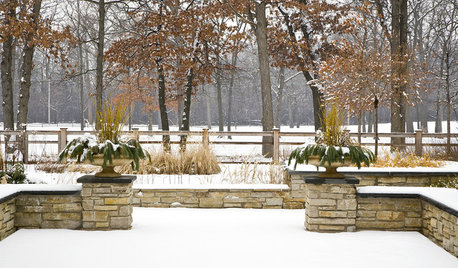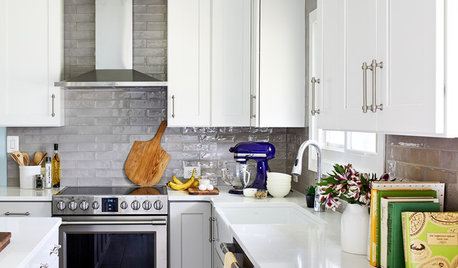Why does hypertufa crack?
I've been making hypertufa pots and other objects for two years now and have noticed that some of them seem to suddenly develop cracks months after they've been made. I've done internet searches and can find very little on hypertufa pots cracking... surely this must be an issue within the hobby. I would venture that approx. 10-15% of our pots have small cracks... and nearly always in the same places. They all start at the top lip and proceed down, never any other places... most are barely visible and only go down an inch or two. On the square shaped pots its always mid-way and never found near a corner... almost always in a pair of cracks found on opposite sides across from either other and the other two perpendicular sides remain crack free... I think this is because the two cracks on opposing sides release the stresses. These cracks appear far less frequently on round shaped pots and have yet to appear on any solid projects I've made. Though these cracks can show up at anytime, more often they appear after several months, a day or two after a thorough watering. Other pots from the same batch will not have cracks which tends to have me believe its not so much recipe/ingredient related nor is it curing related. The way I see it is cracks are visual proof there are tensile forces at work at the top of these pots and since cement is known to have a deal of compressive strength but almost no tensile strength, it will crack under relatively little tensile stress regardless of the aggregate used. Sand and gravel only add to concrete's compressive strength and do nothing for its tensile and shear strength... that's why rebar or wire mesh is added, to provide the tensile and shear strength needed in structural applications where shear and tensile forces will be a factor. All perlite does is reduce compressive strength and adds nothing to tensile properties... and peat, like most organic matter added to cement, actually reduces all mechanical properties, even more so over time as it decomposes. In some of my batches I've used glass fibers (well mixed) to add some reinforcement and flexibility... I also add some nylon fibers to prevent plastic cracking (micro-fractures that can appear during the plastic state of cement curing), also tried adding a small amount of acrylic fortifier (which mainly enhances bonding adhesion). They don't seem to make a lot of difference prevent of the types of cracks I'm talking about.
Now I must mention that my pots are not thick proportion-wise... example an 8" pot might have a (very densely compressed) 3/4" wall thickness... I don't like large bulbous 'hobbit' shapes that use 3" walls leaving behind a tiny thimble's worth of potting soil remaining for the plant. So, short of adding wire mesh, does anyone have any proven ideas on how to prevent cracking at the lip permanently.
The most recent event that prompts my search for an answer are two (very wide square) pots that recently had cracks suddenly appeared the very next day after a thorough watering... they were "inside" pots, not exposed to the elements or freezing temps, though the air is quite dry indoors here in the winter. My guess as to the cause at this point is it must have something to do with the lower portion of the pot soaking in a lot of water and trying to expand in circumference at the bottom while the top lip is still dry and so can't respond by also expanding, thus a building up a tensile force at the lip which ultimately split (aka cracked) in order to finally release the tensile force and allow the bottom to expand.
Comments (38)
billie_ann
10 years agolast modified: 9 years agoBeen making pots for a long time and never had the cracks you have. I don't use any fibers, plasticizers, wire or acrylic fortifiers. I also don't have 3" walls unless it's a very large piece, 3' long or longer.
What recipe are you using? How are you curing your pieces?monomer
Original Author10 years agolast modified: 9 years agoNEVER??? Really?
I've used a myriad of recipes as I have now made well over a hundred pots and other hypertufa objects (its likely nearer to two hundred actually). For all my earlier pots I've used the standard 1/3 peat/perlite/cement mix (this has been the vast majority of my batches)... however I've also used coir, vermiculite, EPS (polystyrene beads), sand, diatomaceous earth, kitty litter, clay, pine needles, wood chips in various combinations at one time or other. Currently (in winter) I basically do a two-week moisture cure (meaning in a plastic bag in the house @ 70F) followed by another week to a month or more outside of the bag laying around the house before giving it a dilute vinegar wash and rinsing. Some are planted and some are still not... the only pots that have cracks are planted pots, NEVER while unplanted. During the summer the curing pots in their plastic bags are left outdoors in the backyard where they might get a little direct sun but mostly are in shade, then once out of the bag they were left in the sun for a few weeks before put into service or stored under an overhang.
Having made so darn many of these things, really there is no 'set' recipe and exact curing procedure that has been the standard for all of them. Even so the thing is there appears to be no pattern because I generally make a bunch of pots out of the same batch at the same time and they cure side by side yet only one or two from that batch might ever develop cracks months later. So I'm thoroughly convinced its neither recipe nor curing related... that's why I'm pursuing it as either design or environmentally caused.
BTW, there are others who have experienced these same cracks without solution (I've read those threads) however no one seems to have any real answers other than to say they've never had a pot crack but that's not much help to someone who has experienced it.
My current project is a highly unusual shaped growing container that is especially prone to cracking from the outside-in due to its wide flares... this is why I'm probing around to see if anyone understands what the cause is and has a solution before I continue to make any more of these. So far the only solutions I have in mind involve either increasing weight or cost or both... I'd prefer the extreme light-weight, breathability and ultra cheap cost of 'standard' hypertufa... with that in mind I'm open to suggestion to the cause and a solution.
Related Professionals
Arnold Landscape Architects & Landscape Designers · Aurora Landscape Contractors · Edmond Landscape Contractors · Peabody Landscape Contractors · Aloha Landscape Contractors · Belvedere Park Landscape Contractors · College Park Landscape Contractors · Cudahy Landscape Contractors · Deerfield Landscape Contractors · Gloucester Landscape Contractors · Methuen Landscape Contractors · Petaluma Landscape Contractors · Rockville Landscape Contractors · West Chicago Landscape Contractors · Wilsonville Landscape Contractorsmonomer
Original Author10 years agolast modified: 9 years agoBTW, I'd like to add that none of these are deep structural type cracks... in fact, my wife didn't even notice any of them until I pointed them out and now she thinks they add character to the pieces... go figure. I need my reading glasses to find most of them but as small as they are I am still bothered by them and would like to be able to prevent them from occurring.
Mike Larkin
10 years agolast modified: 9 years agohow about a few photos.
I have experienced cracks but mostly after being outside for some time.
I can say that the biggest problem I had with cracks was when I first started and I was making them in the garage in the winter and they did not cure properly. Or if they cured too fast.
I am not making that many pots.
I use 1/3 potting soil, 1/3 Portland, 1/3 perlite. sometimes vermiculite, sometimes sand, occasionally use bonding agent, only use fibers for the really big pots.
Most cure 2 weeks in bag outside, wet all the time. in the shade - just because it is close to the hose. Wash off well and plant.
I usually do not start making until the outside temps are warmer. Maybe around 50 FHere is a link that might be useful: photos of my hypertufa
club53
10 years agolast modified: 9 years agoConcrete is by its nature "cracky". Surface fractures are not unusual. I have found after making hundreds of pots that, for me, the best assurance against cracks is really hard compressing of the mixture while making the pot, also making sure to mash down on that top lip and seal it against water/rain seeping in. I do use the fiberglass fibers for insurance. It is said that the fibers inhibit the micro-cracks from joining the Concrete Cracking Brothers Union and making a larger crack, but I really don't know. As I sell my pots, I err on the side of caution so that no one returns a pot because it didn't hold up.
I prefer curing the pots in a water bath; they seem to cure faster and harder. After the initial cure, the pots come out of their molds and are immersed in a tub of water, or if you have a pond throw them in. Depending on my schedule, I just leave them in the water for two or three weeks, or longer if I forget about them.
Little pots can be made with thinner walls as these pots are not subjected to the stresses of the weight load of large amounts of soil, made heavier with water, expansion from freezing, etc.
Well, that's what I've learned; maybe it will help lol
billie_ann
10 years agolast modified: 9 years ago"•Posted by monomer none (My Page) on
Sat, Jan 25, 14 at 1:59
"NEVER??? Really?" "
You asked for help and I get disbelief when I try to help. Been working with hypertufa since the 1970's. Other than a too wet mix which resulted in very thick bottom and strange walls, when I first started, I've never had a problem.
When I ask people to post exactly what mix they use, what mold, what release, how big/thick, how long & procedure for curing. It's to help try to find an answer to their problem. Most of the time it's one of those things and most of the time people do not tell you exactly what they did.
There is no "standard" hypertufa mix. There is the original mix and all the variations. You use certain mixes for different looks and functions.
I'll guess you'll have to keep looking for an answer to your problem.monomer
Original Author10 years agolast modified: 9 years ago@Club53... I have a background in engineering and materials, unfortunately its in polymers and not concrete. However the principles of analysis of applied forces/stresses, mechanics of design and physical properties still remain the same and are wholly applicable to cementitious type mixtures. What I needed to do was research the specifics of cement and various types of concretes and then apply that knowledge to hypertufa. This I've been doing and have found that you are entirely correct in your advice. Strength gain from submerging is going to be marginally greater that simply being stuffed in a sealed plastic bag. A 7-day cure is mandatory but 2 weeks is even better and 3 weeks will add a bit more and a 28-day cure a little bit more, etc. etc. etc.
A major take-away from my research is: ALL cementitious materials WILL crack at some point, this is an accepted fact within the industry and is considered as inevitable... as you say the stuff is inherently "cracky". The physics of hydration demand this. Cement typically has a tensile strength that is only 5-10% of its compressive strength and since the hydration process will continue for 30 years or more, this means it continually shrinks over time yet has little tensile strength to resist the ever increasing stresses. This constant shrinking guarantees it will crack... and when little cracks get together they become bigger cracks and is the ultimate failure mode for even perfectly made and cured cementitious constructions.
The addition of 'light' aggregates (perlite, vermiculite, polystyrene) greatly reduce ALL the mechanical properties, both compressive, tensile, flexural, shear and impact. The addition of organic matter only worsens this by creating large channels of space after the peat, coir, sawdust, etc rots away... this can happen within mere months in the case of peat. This means the mode of destruction for all properly made hypertufa is going to be the same... they will self-destruct by crack propagation... as you say 'joining the cracking brothers union', that is inevitable. So the only question is what steps to take to delay the inevitable for as long as possible. Your advice is well thought out.
Everything that will increase compressive strength will likewise increase tensile strength (and flexure as a by-product) too as this is still going to be found as a 5-10% ratio of compressive strength. The submerged curing for increased length of time is a good suggestion as is to tightly compact the lip since this puts it under compression which is similar in principle to the concept of why pre-stressing concrete works to allow greater tensile loads to be absorbed. To your excellent suggestions I will add and say that a lower water to cement ratio will also increase strength... lowering the volume of organic matter incorporated as a percentage will also increase strength. The addition of anything that has inherent tensile strength (fibers do this especially well because of their aspect ratios... meaning their shapes are long and skinny like a rope being used in a tug-o-war) and a strong bond to the cement will increase tensile strength by preventing the small micro-cracks from growing (joining the union)... there are polymer additives that will enhance this fiber bonding thereby increasing this transfer of tensile stresses to the fibers to resist.
I too am beginning to sell my quite unique looking products to the public and so cannot afford to have them begin showing cracks a few months or in a year or two even... doesn't matter if its only the aesthetic 'character' type cracks that don't really affect it structurally. I believe I've effected a solution in my situation using modern technology and a re-design that keeps the lightness of standard hypertufa while adding tremendously to the tensile strength and impact resistance of my wares and yet only increases cost per item by mere pennies... however only the test of time will tell me for sure how well they actually do hold up.
Bottom line is ALL cementitious composites WILL crack and the only strategy is to try to delay the onset of the inevitable crack propagation failure.
club53
10 years agolast modified: 9 years agoWhat do you add to your mixture to give it more strength?
Adding more concrete, after a point, defeats one of the purposes of hypertufa -- by adding weight back in.
Yes, if the hypertufa mixture is too wet, it does make the product weaker. I tell my students "you can pay me now or you can pay me later". The mixture may be easier to deal with today, but you will lose it on the other end with a shorter life to the pot. Same thing about curing. I do three weeks minimum, usually 28 days. I suppose if a trough were to be planted and put outside, rain, dew and plant watering will help in keeping up with the cure if someone is in a hurry.
slowjane CA/ Sunset 21
9 years agolast modified: 9 years agohypertufa newbie here!
just reading through this thread among others and curious what your final recipe was monomer? (are you still here?) if you solved it, sure would be curious to know!
slowjane CA/ Sunset 21
9 years agolast modified: 9 years agoand billie_ann what is your recipe? if you've posted it elsewhere, my apologies. you seem to have a ton of experience and was wondering what works for you.
thanks all!
powers1
9 years agoI can't tell you how helpful @monomer was in breaking down the elements leading to hypertufa cracks. I have been making and selling hypertufa for a year, mostly small indoor planters for cactus and succulents. Over the winter, the hypertufa pots that I planted and kept for myself (indoors) have developed cracks starting from the lip and moving downward. Some are minuscule, some have grown to be noticeable, but no pots have fallen apart. In concurrence with @monomer , these pots are always planted, never empty. I use a 2:3:3 (peat, perlite, portland) ratio, with a 4wk damp plastic wrapped cure, and a week long water bath to leach out alkalinity. I know that this thread has been quiet for a while, but am hoping someone has found a solution or remedy?
Annie
9 years agoI have had the same problem, but with almost all of my hypertufa mixtures. I've never had a concrete pot crack, but I have been making different kinds of hypertufa pots for about 6 months now that have 1 part concrete to 3 parts vermiculite or perlite, and they always crack within a few weeks of planting. I've increased the vermiculte but am still having the problem. They last longer if I use less water and really pack them down, but they still eventually get the hairline cracks that grow larger in time. I keep them in a damp hefty bag for two days and then put them in a water bath for a month. I was wondering if it was because I'm in a very dry area and that combined with watering the plants quite often when it's hot was causing the cracks. I've even had a couple 2" thick "standard" hypertufa pots crack. Has anyone tried wire mesh and if it makes a difference, can you please tell me where to get it and whether it's difficult to use on 1" thick pots? I like to use bowls because they're better for succulents.
powers1
9 years agoChecking back in with some new discoveries:
I have changed my recipe to the following
3 parts Portland
3 parts peat
2 parts perlite
1 part vermiculite
1 part sand
This has resulted in a MUCH stronger product. I uncast them 24 hrs later and they are still workable but I haven't lost one to breakage yet. The varied sizes in aggregate seem to result in a much tighter mix. Obviously time will show if these pots will develop cracks after being planted...but as of now I'm thrilled with this recipe.Annie
9 years agoAlso, has anyone tried the cement/vermiculite mixture without the peat moss? I really like the smooth look after it's sanded down, but it cracks eventually every time. Even the really small ones.
club53
9 years agoI get the big bags (20 pounds) from a nursery supply. the little bags at HD are too expensive for the amount of perlite I need.
I don't use vermiculite very often because it doesn't give the volume I need. It makes a denser trough, (less volume) but I do like the sparkles.
Can't really comment if leaving the peat moss out causes cracks or not; doesn't make sense to me, but I could be wrong. For me, the cracking has to do with how dense the trough is packed when being made. Also,Portland does expire after a while, so be sure it is fresh...keep moisture away from it prior to use.
Mark Melonas LUKE WORKS
8 years agoHow much water in relation to your dry ingredients? Are you adding water by weight/volume or by feel? When we make concrete for furniture and sinks we are very careful to dose the water as low as possible for ultimate strength. Our ratio is about water : cement, 0.32 : 1.
Mark Melonas LUKE WORKS
8 years agoGreat discussion by the way. Similar to ones I have with my concrete friends.
monomer
Original Author8 years agolast modified: 8 years agoMost use water ratios on the order of 1:1 or even greater... I understand that this is outrageous where conventional concrete is concerned but hypertufa has perlite and peat. The porous perlite will account for more water absorption than aggregates such as sand and gravel but the real water hog is the peat moss. Peat will absorb huge quantities of water... and though I believe the peat will release it to the cement as needed for hydration (which as you know is not very much... far less than your .32:1) the resulting hypertufa mix is not really workable unless you have much more water incorporated... and thus yet another issue.
I have confirmed it to my own personal satisfaction that the premature cracking of hypertufa pots is due to water absorption by the peat causing expansion... if the rate is faster than the moisture can soak through the whole pot then there is the risk of the tensile forces overcoming the inherent weakness of the hypertufa medium (mainly the weak perlite and the hollowed out structures caused by the organic matter, the peat). I do not believe the cement is the weak link here but rather the perlite and peat incorporated. There are two factors (in my case) that precipitate the cracking... 1) a very dry atmosphere (usually under 35-40% for several days or weeks) where the pot is allowed to dry completely out (which is often the case when growing succulents in these pots during the winter months up north) 2) followed by a good soaking... within 24 hours (often less than an hour or two) a small thin crack or two will emerge always starting at the top and slowing going down. NONE of the other structures I make from hypertufa (solid spheres, motifs, sculptures, etc) exhibit this problem... and many are left outside all year round. The key, is the rate of expansion due to a sudden addition of water to very dried-out hypertufa. I have found (I believe) several ways to mitigate the issue but they all cost money and extra time and added steps. I'm still trying different products and methods to determine which work the best and at what quantities and how best to utilize them. In general, the strategies are to 1) strengthen the hypertufa matrix by using reinforcement (anything with an aspect ratio), 2) increase the elastic/tensile properties of the whole mix (utilizing emulsions), 3) provide a water-proof membrane between the hypertufa and the source of moisture. I've had the best luck pursuing strategies #1 and #3 with only limited successes with #2... but I've also been experimenting with combinations of these all with interesting results and what I believe are successes however it really is too soon to tell... in another year I should have more definitive answers as to what will work and what only offers moderate improvement at best.
Annie
8 years agoI use vermiculite and cement only, and add acrylic hardener to the water. I use just enough water to allow me to pack it tightly into the mold. With the true hypertufa I added peat moss, and haven't had a problem with that cracking, just the cement/vermiculite mix. I've recently added cement, increased the amount of vermiculite, and also added a metal ring to the top (about 3/8 of the way down to add strength at the top). It hasn't been long enough to tell if it's successful, but I did want to mention that I cure all pots in a tub of water for 30 days.
daisy_ny6
8 years agoI thought that the point of adding peat to the mix was that it would weather away rather quickly to give a more natural, rough, stone-like appearance.
I like cement (with a bit of iron oxide for color and strength), vermiculite for sparkles, perlite for lightness and sand for strength along with plasticizer and fibers. I like the look of it polished, but that is usually too much time and work for the result. I laminate over steel chicken wire or building mesh, sometimes over styrofoam. I've only had problems with cracking when I've dropped a piece, but using a colored grout for repair enhanced the look, I think.Sandy Troy
8 years agoHi All, Thought some might be interested in this graph on cement compression strength... which makes a case for curing hypertufa (moist & bagged) for at least 28 days. Formula I am happy with is a ratio of 1 part cement to 3 parts aggregate (1 part portland cement, 1 part peat, 1 part perlite, 1 part vermiculite). all the best

club53
8 years agoWithout getting too scientific about the whole issue: recently after 12 years of making hypertufa troughs, I had a bunch of troughs fail to cure. Naturally, I was under a time deadline and needed those troughs for sales and customers. This never happened even to the first troughs I ever made. The first suspect was "dead" Portland, but after a new bag, same failures. So, I tried just Portland and sand, the item set up perfectly. My attention then turned to the peat moss. The problem turned out to be the peat moss was soooo dry it was "stealing" the water from the Portland, which cannot cure without water. Immersing the troughs in tubs of water did not solve the problem; the water had to be sufficient for the Portland when the mixture was first made prior to packing it into the trough for the Portland to cure..
So, if troughs aren't curing; check that water!
Annie
8 years agoSo are you saying that you are now using more water? Would it help to soak the peat moss overnight before you mix?
club53
8 years agoI used more water; Rule 101 of making hypertufa used to be to mix the dry ingredients extremely well so that the Portland would coat the other ingredients. I don't know if moistening the peat moss would defeat that purpose.
J Seven
8 years agoHypertufa is a type of concrete. Any concrete would crack if it is not armed. So you have to use any fibers to bond grains (paper, coir, synthetic, fiberglass, etc.). Expanded clay is good to arm, as well as you would use meal broth (instead of water) to glue grains still portland hardens.
Annamaria Szotyori
6 years agoHi everyone, I have made so far few hundreds of pots, and have the exact same problem with cracks, word by word, as mentioned by monomer in 2014. I was wondering if anyone got some answers since then. Please share....
poaky1
5 years agoHi guys, I was wondering if these fiberglass fibers were available somewhere in particular? I do have lottsa fence on a roll, you know the steel or aluminum garden fence? I was wondering if I could use either or both of them to reinforce a hypertufa planter? I have a square metal planter, and I was going to use the metal planter for a "form" and build a form of hypertufa on the outside of this metal planter, I would put some sticks or something to make drainage holes in the form. I have a book that has many recipes for hypertufa in it, but, I do like the 3 parts Portland cem, 3 parts peat, 2 parts perlite, 1 part verm and 1 part sand. I do forget who listed that recipe, but, in my book there are many recipes. But, If I did want to use a recipe with a fiberglass filter additive, maybe some cheap furnace filters would provide some "fiberglass fibers"? But, I do think I could use my metal fencing material also, and that would stop cracking, along with curing the piece in some water that covers the whole piece. I happen to have a good bit of metal fencing, the kind that is in tiny squares, like a half an inch squares on a roll, because I used to ,have bunnies, and the fence was made out of these tiny squares of fence, so hey I can use this fencing to reinforce my planters. But, really, can I use cheap furnace filters for "fiberglass fibers"?
Mark Melonas LUKE WORKS
5 years agohey @poaky1. There are several fibers available for use in concrete- not all are fiberglass, but fiberglass is widely used. I use them for making concrete furniture and sinks. I'm sure people have used them for hypertufa... but I'm not a hypertufa person.
- First is Fiberglass Scrim - a woven mat of fiberglass;
- Fiber glass fiber - Alkali Resistant - is important for use in concrete
- PVA fibers - smaller and more flexible than the Fiberglass, available in a few sizes
- Acrylic fibers - very tiny, can "choke" the mix - you need very small amount.
I buy my fibers from BUDDY RHODES concrete products. http://www.buddyrhodes.com/reinforcements-1/
Sounds like you have some materials that are "fiber-like" your fence material and the furnace filters.I think the some PVA fibers from Buddy Rhodes - probably the PVA 100s or 15s would be the most useful. You would not need very much. you could sprinkle them into the mix as you work it by hand and smoooosh it all together, the PVA fibers will really help with shrinkage cracks and overall strength. - and its not too expensive to get a small bag or two.
dcrews21
5 years agoAdd a fortifier to your hypertufa mixture. It causes it to be a bit more elastic, thereby minimizing the freeze/thaw cracking. Here are some: http://www.artistic-garden.com/how-much-liquid-fortifier-to-use-in-hypertufa-concrete-recipes/
poaky1
5 years agoHey guys, I'm liking that Elmers glue, and latex paint suggestion, cheap, and possibly just sitting in a can downstairs, IF, it's not a solid mass of dried up crap by now, paint, that is.
I have had some projects that haven't cracked, BUT, some that have. I'd always heard that HYDRATION was key in having a finished project NOT crack, you know, to hydrate it long enough before taking it off and using it.
I'm hoping that IF I can't use my old latex paint that is downstairs, IF it's all hard and non usable, AND, I hit up the local WM paint section, and buy some god ugly color that is REDUCED majorly, I'm HOPING that my Hypertufa project WON'T be showing streaks of the god ugly color through it. I want to make a hypertufa planter for succulents. I'm guessing the liming effect of the cement may make the paint color less likely to be bright or showy?
I remember buying a small amount of "silica fume" years ago, and never using it, I wonder IF I can use that on this project OR would it be big waste of it, that I should use on a much more delicate project? Really, anyone who knows just what one would use "silica Fume" for, please tell me, I forget what I bought it for, and, if it goes bad quickly, I am sure it has been way too long to use it now.
BTW, I have an OPENED BAG OF PORTLAND Cement, it's been open for a few years at least, can I still use it? I've seen cement sitting outside in a heap outside of a place that makes and sells concrete statues, surely sitting in my basement in a bag it's fine, right?
Mike Larkin
5 years agoDo not use opened , old Portland.
IMHO I believe the fibers are overkill for small projects . Maybe if you are making a 3ft by 4ft trough.
Hypertufa is like concrete ( the peat, perlite maybe sand ) will bond with the portland - Why add one more thing.
Fibers are great if you are building sidewalks, or maybe cement columns but I am not understanding how fiber help with this original problem. These a small pots. I am guessing that there are parts of the curing process that was not followed properly -
Do not use excessive water when you make the hypertufa, I have used ad mix like bonding agent or whatever. It seems to help. I agree the peat that is too dry can effect the curing process. I read of lots of problems with to dry peat.
I have used bags of potting soil and they have always been damp when I open.
I mix 1/1/1 cure for 3 weeks and rarely have issue with cracks.
poaky1
5 years agoI've never heard of fibers (metal embedded,yes) being used for a sidewalk or column. I was wondering how to mix paint or Elmers glue into a hypertufa mix as it is so dry and hard to mix.
I haven't made my trough yet. I'll be curing as long as possible.
















club53